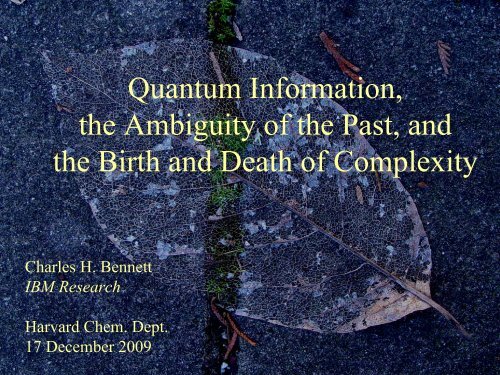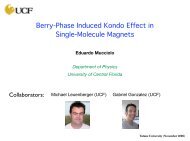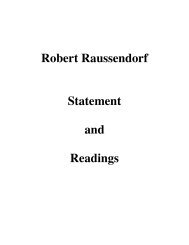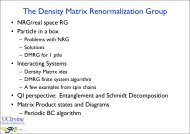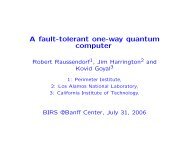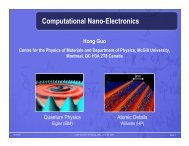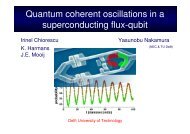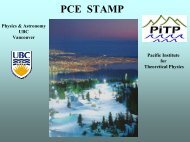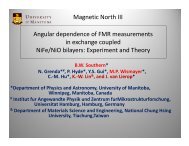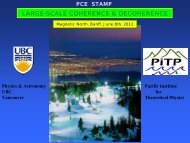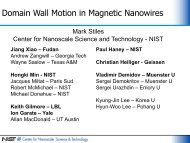Quantum Information, the Ambiguity of the Past, and the Birth ... - PiTP
Quantum Information, the Ambiguity of the Past, and the Birth ... - PiTP
Quantum Information, the Ambiguity of the Past, and the Birth ... - PiTP
Create successful ePaper yourself
Turn your PDF publications into a flip-book with our unique Google optimized e-Paper software.
<strong>Quantum</strong> <strong>Information</strong>,<br />
<strong>the</strong> <strong>Ambiguity</strong> <strong>of</strong> <strong>the</strong> <strong>Past</strong>, <strong>and</strong><br />
<strong>the</strong> <strong>Birth</strong> <strong>and</strong> Death <strong>of</strong> Complexity<br />
Charles H. Bennett<br />
IBM Research<br />
Harvard Chem. Dept.<br />
17 December 2009
Reasoning from classical mechanics, Laplace thought <strong>the</strong> future<br />
<strong>and</strong> past were fully determined by <strong>the</strong> present, but attributed <strong>the</strong><br />
perceived ambiguity <strong>of</strong> <strong>the</strong> future to our imperfect knowledge <strong>of</strong><br />
<strong>the</strong> present, <strong>and</strong>/or our lack <strong>of</strong> sufficient computing power to<br />
predict <strong>the</strong> future. An omniscient God would know past, present,<br />
<strong>and</strong> future.<br />
<strong>Quantum</strong>ly, <strong>the</strong> future is less determined than Laplace imagined.<br />
Even an omniscient God would not be able to predict whe<strong>the</strong>r a<br />
particular radioactive atom will decay within its half life.<br />
But past macroscopic classical information is generally regarded<br />
as definite <strong>and</strong> unambiguous. Of course some microscopic events<br />
in <strong>the</strong> past (e.g. which path an unobserved photon followed<br />
through an interferometer) are regarded as being ambiguous in <strong>the</strong><br />
same way as future quantum outcomes.
After <strong>the</strong> experiment is over, even God doesn’t<br />
remember which path <strong>the</strong> particle followed.
Monogamy <strong>of</strong> Entanglement<br />
• If A <strong>and</strong> B are perfectly entangled with each o<strong>the</strong>r, <strong>the</strong>y cannot be<br />
even classically correlated with anyone else.<br />
• If B tries to share his entanglement with a third party, or lets it get<br />
eavesdropped on by <strong>the</strong> environment, his entanglement with A<br />
becomes degraded into mere classical correlation.<br />
“Two is a couple. Three is a crowd”.<br />
ψ<br />
|0〉<br />
entangled<br />
only classically correlated<br />
|0〉
(This typically happens when <strong>the</strong> environment is not at <strong>the</strong>rmal equilibrium,<br />
<strong>and</strong> when it contains many subsystems that interact more strongly with <strong>the</strong><br />
system than with each o<strong>the</strong>r <strong>and</strong>… The earth’s environment is like that.)<br />
What does it mean for information to be “classical?”<br />
ψ<br />
System<br />
Environment:<br />
<strong>Information</strong> becomes classical by being<br />
replicated redundantly throughout <strong>the</strong><br />
environment. “<strong>Quantum</strong> Darwinism”<br />
Blume-Kohout, Zurek quant-ph/0505031 etc.<br />
Measured in 0/1<br />
basis, it yields<br />
many redundant<br />
copies <strong>of</strong> <strong>the</strong><br />
system’s information.<br />
In o<strong>the</strong>r<br />
bases it does not.
In <strong>the</strong> practical trade<strong>of</strong>f<br />
between Publicity <strong>and</strong><br />
Privacy, digital technology<br />
has created a problem<br />
<strong>and</strong> an opportunity<br />
Cheap, easy-to-use video cameras <strong>and</strong> cheap data storage leads to<br />
<strong>the</strong> temptation to record everything happening in public or even<br />
private places <strong>and</strong> save it forever, with ensuing loss <strong>of</strong> privacy, <strong>and</strong><br />
potential loss <strong>of</strong> liberty, if despotic rulers get control <strong>of</strong> <strong>the</strong> data.<br />
But <strong>the</strong>se recordings are sometimes good, deterring governmental as<br />
well as individual misconduct. In many situations <strong>the</strong> bad guys<br />
want privacy for <strong>the</strong>ir misdeeds, while <strong>the</strong> good guys want<br />
publicity, with au<strong>the</strong>nticity.
To <strong>the</strong> amazement <strong>of</strong> most <strong>of</strong> <strong>the</strong> rest <strong>of</strong> <strong>the</strong> world, some<br />
Americans think it is good for society for everyone to carry a gun.<br />
A better idea would be for everyone to carry a camera.<br />
Public policy would <strong>the</strong>n encourage amateurs to make audiovisual<br />
recordings, but restrict how <strong>the</strong> recordings could legally be used.<br />
(Yes for exposing crime <strong>and</strong> injustice; No for blackmail).<br />
CNN billboard in Delhi:<br />
If you see it, shoot it—<br />
Every citizen a photojournalist.
Returning to Science, it seems <strong>the</strong>re are 3 levels <strong>of</strong> privacy.<br />
• <strong>Quantum</strong>: <strong>Information</strong> like <strong>the</strong> path taken in an<br />
interferometer, that exists only temporarily, <strong>and</strong> afterward<br />
can best be thought <strong>of</strong> as never having existed.<br />
• Classically Private: <strong>Information</strong> that has been<br />
amplified to <strong>the</strong> point <strong>of</strong> becoming classical, but is not<br />
widely distributed in easily recoverable form. Humans<br />
can erase it, <strong>the</strong>n lie about it with impunity, although<br />
perhaps not without guilt.<br />
• Public: <strong>Information</strong> that is so widely distributed that<br />
it is infeasible to conceal. Lying about it only makes you<br />
look foolish.
Nowadays, it is tempting to<br />
believe that once information<br />
has become public, it can<br />
never be wholly destroyed.<br />
The modern world appears<br />
very different in this regard<br />
from <strong>the</strong> ancient pre-<br />
Gutenberg era, when major<br />
literary works were written<br />
down, performed, <strong>and</strong> widely<br />
known, but <strong>the</strong>n lost.<br />
Ancient Greek poet Sappho, ca 620-525 BC,<br />
as depicted by Gustav Klimt ca 1900.
In China, <strong>the</strong> Classic <strong>of</strong> Music, or Sixth Classic, is thought to have<br />
been lost in <strong>the</strong> book-burning instigated by Emperor Qin Shi<br />
Huang in <strong>the</strong> 3 rd century BC, though some general knowledge<br />
about it survives. Fortunately, Confucian scholars had memorized,<br />
<strong>and</strong> later managed to reconstruct, many <strong>of</strong> <strong>the</strong> o<strong>the</strong>r destroyed<br />
works.<br />
Sappho’s poems were lost more gradually, through neglect :<br />
once widely reproduced <strong>and</strong> taught, <strong>the</strong>y fell out <strong>of</strong> favor when<br />
her Aeolian dialect <strong>of</strong> Greek died out. They were no longer<br />
taught, <strong>and</strong> <strong>the</strong> existing manuscripts were discarded or repurposed.<br />
More recently, in India, after surviving nearly 2000 years, <strong>the</strong><br />
Carvaka school <strong>of</strong> philosophy is thought to have died out around<br />
<strong>the</strong> 15 th century, along with all its original texts, except for<br />
fragments quoted in <strong>the</strong> writings <strong>of</strong> its Hindu <strong>and</strong> Buddhist<br />
opponents.
Even in today’s world, much macroscopic, publicly accessible<br />
information is seemingly lost because no person, nor any natural<br />
process, happens to record it in a durable medium.<br />
Dried mud with cracks<br />
<strong>and</strong> raindrop craters in a<br />
river bed in Las Vegas,<br />
USA in 1965. A few<br />
days later <strong>the</strong>se details<br />
were washed away by a<br />
subsequent rain.<br />
If no one had photographed<br />
<strong>the</strong>m, would a<br />
physical record <strong>of</strong> <strong>the</strong>m<br />
still exist?
It is tempting to believe that such macroscopic information is not<br />
really lost, just that it becomes so diffusely <strong>and</strong> complexly spread<br />
out as to be irrecoverable in practice while being still recoverable in<br />
principle. When a book is burned, its contents are in principle still<br />
recoverable from <strong>the</strong> exact state <strong>of</strong> <strong>the</strong> smoke, ash, <strong>and</strong> heat it<br />
generates.<br />
Could it be that every macroscopic past phenomenon, say Sappho’s<br />
lost poems, or <strong>the</strong> fate <strong>of</strong> mysteriously disappeared persons like <strong>the</strong><br />
physicist Ettore Majorana or computer scientist Jim Gray, can be<br />
recovered from physical evidence in principle, if not in practice?<br />
To believe o<strong>the</strong>rwise is venturing dangerously close to <strong>the</strong><br />
postmodernist view, abhorred by most scientists as arrogantly<br />
anthropocentric, that <strong>the</strong> past (or maybe even <strong>the</strong> present) has no<br />
objective reality independent <strong>of</strong> human belief systems, <strong>and</strong> <strong>the</strong>refore<br />
that it is pointless to inquire what “actually” happened.
But I think some information really is lost, not from <strong>the</strong> universe but from <strong>the</strong><br />
world (i.e. <strong>the</strong> planet Earth). Why? –because most information we might care<br />
about is washed away by much larger entropy flows into <strong>and</strong> out <strong>of</strong> <strong>the</strong> Earth.<br />
The Earth has finite information storage capacity, but it exports a lot <strong>of</strong><br />
r<strong>and</strong>omness (generates a lot <strong>of</strong> entanglement with its environment, in <strong>the</strong> quantum<br />
way <strong>of</strong> speaking) in <strong>the</strong> form <strong>of</strong> <strong>the</strong>rmal radiation into <strong>the</strong> sky.<br />
Thermal entropy export rate ≈ 300 watts/sq meter at 300K<br />
≈ 10 30 bits per square meter per year.<br />
Geological information capture rate in “hard” degrees <strong>of</strong> freedom, stable for<br />
geological times against <strong>the</strong>rmal motion (e.g. atomic substitutional disorder <strong>and</strong><br />
crystal lattice defects in solid rock <strong>of</strong> earth’s crust) = crust thickness (≈10 km) ×<br />
rock information density (≈1 bit/cubic nm) / rock lifetime (≈ 10 8 yr)<br />
≈ 10 22 bits / per square meter per year.<br />
Human digital information capture rate 100GB/person x 10 9 people who are<br />
heavy information users ≈10 21 bits per year<br />
(that’s for <strong>the</strong> whole world, not per sq meter)
To catch up with <strong>the</strong><br />
<strong>the</strong>rmal radiation<br />
leaving Earth, one<br />
would need to travel<br />
faster than light. So<br />
<strong>the</strong> information is<br />
still in <strong>the</strong> universe,<br />
but not recoverable<br />
by us.
So we are motivated to add a new level <strong>of</strong> privacy.<br />
• <strong>Quantum</strong>: <strong>Information</strong> like <strong>the</strong> path taken in an<br />
interferometer, that exists only temporarily, <strong>and</strong> afterward can<br />
best be thought <strong>of</strong> as never having existed.<br />
• Classical but Escaped: <strong>Information</strong> that has been<br />
amplified to <strong>the</strong> point <strong>of</strong> becoming classical, but has escaped<br />
from Earth in <strong>the</strong>rmal radiation. Humans have no way <strong>of</strong><br />
recovering it.<br />
• Classically Private: <strong>Information</strong> that has been amplified to<br />
<strong>the</strong> point <strong>of</strong> becoming classical, <strong>and</strong> still resides on earth in a<br />
few places, though it may be infeasible to recover with current<br />
technology.<br />
• Public <strong>and</strong> Permanent <strong>Information</strong> that is so widely distributed<br />
that it is infeasible to erase all <strong>the</strong> copies.
Mysteries <strong>of</strong> <strong>the</strong> <strong>Past</strong>:<br />
Still recorded on earth, though unknown to any human <strong>and</strong><br />
inaccessible with current technology:<br />
• Locations <strong>of</strong> gold rings, dropped in an annual ceremony into<br />
<strong>the</strong> Venice Lagoon over a period <strong>of</strong> several centuries, to<br />
symbolize Venice’s marriage to <strong>the</strong> Sea.<br />
Maybe still recorded on earth, maybe escaped:<br />
• Lost classic writings <strong>of</strong> many cultures<br />
• Fates <strong>of</strong> mysteriously disappeared persons, such as<br />
• Physicist Ettore Majorana disappeared 1938<br />
• Labor leader Jimmy H<strong>of</strong>fa disappeared 1975<br />
• Computer Scientist Jim Gray disappeared 2007<br />
Escaped:<br />
• Unrecorded raindrops from past rain storms.<br />
• Pattern <strong>of</strong> rice grains in today’s lunch sushi.
How to obliterate earthly evidence <strong>of</strong> Jimmy H<strong>of</strong>fa’s demise?<br />
(Former US labor leader disappeared in 1975, presumed<br />
murdered by <strong>the</strong> New York City Mafia, but body was never<br />
found. Police are still searching.)<br />
• Cremate his body <strong>and</strong> let <strong>the</strong> smoke <strong>and</strong> heat escape<br />
• Dissolve <strong>the</strong> ashes to make a clear liquid, with no solid<br />
fragments, <strong>the</strong>n pour <strong>the</strong> liquid into <strong>the</strong> ocean<br />
• Don’t tell anyone you did it, even on your deathbed<br />
• For good measure, have yourself cremated <strong>and</strong> your ashes<br />
dissolved to make sure physical traces <strong>of</strong> your memory are<br />
thoroughly gone.
What can we do to make a particular chosen body <strong>of</strong><br />
information long-lasting (say until <strong>the</strong> sun turns into a red<br />
giant)?<br />
Why would we want to?<br />
- To preserve important works <strong>of</strong> literature<br />
- To preserve evidence <strong>of</strong> a crime until it is safe to publicize,<br />
<strong>the</strong>reby discouraging crime even in times <strong>of</strong> despotism <strong>and</strong><br />
corruption<br />
- Because we hate postmodernism <strong>and</strong> want to make even<br />
unimportant details <strong>of</strong> <strong>the</strong> past uncontestable.<br />
Record <strong>the</strong> information in a durable digital medium, <strong>and</strong> bury<br />
many copies in geologically stable rock formations in various<br />
parts <strong>of</strong> <strong>the</strong> world, as if it were nuclear waste.
But suppose we wanted to store not all or most, but a lot <strong>of</strong><br />
information, say a real-time video surveillance <strong>of</strong> entire earth<br />
surface at millimeter-millisecond resolution.<br />
This works out to about 10 16 bits/sq m year, well within<br />
geological capture rate.<br />
Is this scary thing perhaps happening already, automatically,<br />
without deliberate human effort, just because frozen accidents<br />
in newly formed rock in a sense provide a hash <strong>of</strong> <strong>the</strong> current<br />
state <strong>of</strong> <strong>the</strong> earth?<br />
Probably not, due to r<strong>and</strong>omizing effect <strong>of</strong> dynamics:<br />
recovering a minority share <strong>of</strong> <strong>the</strong> output <strong>of</strong> a known r<strong>and</strong>om<br />
permutation (or known r<strong>and</strong>om unitary) reveals almost nothing<br />
about a minority share <strong>of</strong> its input.
Some fur<strong>the</strong>r Questions<br />
• Is it really impossible to recapture <strong>the</strong> escaped radiation?<br />
• What is <strong>the</strong> ontological status <strong>of</strong> escaped information?<br />
Does <strong>the</strong> universe remember where <strong>the</strong> raindrops fell, even<br />
after all terrestrial evidence is gone?<br />
• Is r<strong>and</strong>om input (e.g. entropy <strong>of</strong> incoming solar radiation)<br />
necessary to make <strong>the</strong> earth forget things?<br />
• Even after classical information is lost from “hard”<br />
geological storage, might it still be retained in <strong>the</strong> earth’s far<br />
more numerous “s<strong>of</strong>t” degrees <strong>of</strong> freedom such as phonons in<br />
<strong>the</strong> earth’s core <strong>and</strong> mantle?
Can we arrange for escaped information to be reflected<br />
back to us later, making it again accessible?<br />
Yes. For specific items <strong>of</strong> non-<strong>the</strong>rmalized outgoing radiation<br />
(e.g. optical earth views, old TV broadcasts) , this could be<br />
arranged, with advance planning, or it might happen accidentally.<br />
Such information could be called extraterrestrial fossils.
But for fully<br />
<strong>the</strong>rmalized<br />
radiation, we<br />
would have to<br />
catch <strong>and</strong> reflect<br />
back so much <strong>of</strong><br />
it, to reconstruct<br />
any particular<br />
item <strong>of</strong> interest,<br />
that <strong>the</strong> earth<br />
would badly<br />
overheat.
• Can we outrun <strong>the</strong> radiation?<br />
For example, one<br />
might hope to outrun<br />
<strong>the</strong> <strong>the</strong>rmal radiation,<br />
because <strong>the</strong> refractive<br />
index <strong>of</strong> interstellar<br />
space is slightly >1.<br />
But this hope is<br />
probably dashed by <strong>the</strong><br />
accelerating expansion<br />
<strong>of</strong> <strong>the</strong> universe (a.k.a.<br />
cosmological constant,<br />
dark energy) which<br />
causes remote objects<br />
now visible (e.g. o<strong>the</strong>r<br />
galaxies) to eventually<br />
become inaccessible.
R<strong>and</strong>omizing dynamics in a representative case.<br />
Though <strong>the</strong> raindrop originates in<br />
quantum <strong>and</strong> <strong>the</strong>rmal fluctuations, it<br />
does not fall in a superposition <strong>of</strong><br />
places. Independent observers would<br />
agree where it fell, <strong>and</strong> as long as <strong>the</strong><br />
drop or its crater exists, reflected light<br />
will generate a torrent <strong>of</strong> replicas <strong>of</strong> <strong>the</strong><br />
information, fulfilling <strong>the</strong> classicality<br />
criterion <strong>of</strong> quantum Darwinism.<br />
However, unless <strong>the</strong> crater is lucky enough to get fossilized, it will<br />
be washed away, <strong>and</strong> its former location will <strong>the</strong>n lose any stable<br />
earthly embodiment. The torrent <strong>of</strong> optical replicas will cease, <strong>and</strong><br />
<strong>the</strong> old optical replicas will escape into space. So it would appear<br />
that <strong>the</strong> classical information, <strong>of</strong> where it formerly was, remains in<br />
<strong>the</strong> universe, but not on Earth.
Ontological Status <strong>of</strong> Escaped <strong>Information</strong><br />
Consider a raindrop that may fall in one <strong>of</strong> 2 locations L or R.<br />
Suppose that it forms, falls, <strong>and</strong> finally evaporates, so that all earthly<br />
record <strong>of</strong> where it fell is lost as radiation into <strong>the</strong> sky.<br />
(LLLL+RRRR) /√2 Drop forms, falls <strong>and</strong> begins to emit radiative<br />
replicas into space. All observers, terrestrial <strong>and</strong> celestial, will see <strong>the</strong> drop as<br />
having fallen in one <strong>of</strong> two places. God sees a cat state-like superposition in<br />
which both outcomes happen.<br />
(LLLLL+RRRRR) /√2 Drop begins to evaporate, emitting<br />
fur<strong>the</strong>r radiative replicas.<br />
(LLLLL+RRRRR) /√2 Drop has entirely evaporated. No<br />
terrestrial information remains about where it fell.<br />
• Conclusion: Escape <strong>of</strong> last replica from Earth restores terrestrial observers to a<br />
more detached, Olympian viewpoint in which both outcomes are equally real.<br />
Escaped information is not so different, after all, from which-path information.<br />
J. A. Wheeler: “The past exists only ins<strong>of</strong>ar as it is recorded in <strong>the</strong> present.”
Escaped information as a kind <strong>of</strong> spontaneous quantum erasure:<br />
•<strong>Quantum</strong> erasure restores product state by undoing a measurement.<br />
•R<strong>and</strong>om unitary radiation gradually restores a near-product state<br />
•A trivial form <strong>of</strong> quantum erasure would be to measure which path,<br />
generating an entangled state between, say, a photon’s path <strong>and</strong> a<br />
monitoring atom, <strong>the</strong>n to discard both <strong>the</strong> photon <strong>and</strong> <strong>the</strong><br />
monitoring atom into <strong>the</strong> environment.<br />
A form <strong>of</strong> information especially susceptible to escape is “which atom” information associated with<br />
<strong>the</strong>rmal motion <strong>and</strong> chemical reactions, during which in many cases <strong>the</strong> atoms follow sufficiently<br />
classical trajectories that one can know, with high fidelity, which <strong>of</strong> several identical atoms in an<br />
initial configuration corresponds to a particular atom <strong>of</strong> that species in a later configuration. For<br />
example, one can say that during fermentation <strong>the</strong> #2 carbon <strong>of</strong> glucose ends up in <strong>the</strong> alcohol, ra<strong>the</strong>r<br />
than <strong>the</strong> carbon dioxide. Normally this is taken to mean that if that carbon were isotopically<br />
substituted, it will end up in <strong>the</strong> alcohol; but it can also be taken to mean that without isotopic<br />
substitution <strong>the</strong> environment in principle eavesdrops on <strong>the</strong> trajectories sufficiently well that it could<br />
attest <strong>the</strong> continuity <strong>of</strong> an atom’s path from sugar to alcohol. I suspect that this kind <strong>of</strong> which-path<br />
information escapes in a time one could estimate in <strong>the</strong> same way as one does <strong>the</strong> information<br />
encoded in s<strong>of</strong>t degrees <strong>of</strong> freedom in <strong>the</strong> earth.
• Is r<strong>and</strong>om input (eg radiation from <strong>the</strong> sun) necessary to achieve<br />
r<strong>and</strong>omization?<br />
No. Unlike a classical system, a deterministically evolving<br />
quantum system can be r<strong>and</strong>omized simply by allowing<br />
information to escape from it.<br />
Pure<br />
state<br />
input<br />
i inaccessible qubits<br />
(escaped)<br />
Known<br />
r<strong>and</strong>om<br />
0 n unitary on a<br />
n = i+a accessible<br />
qubits qubits<br />
Approximately maximally<br />
mixed when i > a.
If <strong>the</strong> earth’s solar input were replaced by a laser beam <strong>of</strong> equal<br />
power, <strong>the</strong> input entropy would be zero while its apparent output<br />
entropy rate would be about <strong>the</strong> same. Thus at a steady state <strong>the</strong><br />
output entropy rate would also be zero, because <strong>of</strong> entanglement<br />
among <strong>the</strong> output modes. The earth would be functioning as a<br />
giant down-converter. Unlike an ordinary down-converter, <strong>the</strong><br />
correlations would be exceedingly computationally complex <strong>and</strong><br />
unobservable in practice.
Up to now, I have considered only geologically stable “hard” degrees<br />
<strong>of</strong> freedom in <strong>the</strong> crust, <strong>and</strong> neglected <strong>the</strong> far more numerous “s<strong>of</strong>t”<br />
degrees <strong>of</strong> freedom (e.g. phonons <strong>and</strong> photons) in not only <strong>the</strong> crust<br />
but <strong>the</strong> whole body <strong>of</strong> <strong>the</strong> earth. These degrees <strong>of</strong> freedom have<br />
entropy about a million times greater than <strong>the</strong> annual radiant entropy<br />
flux leaving <strong>the</strong> earth. Could it be that, if Jimmy H<strong>of</strong>fa had been were<br />
cremated in a way that efficiently coupled to s<strong>of</strong>t degrees <strong>of</strong> freedom<br />
in <strong>the</strong> earth (deep underground, for example), this s<strong>of</strong>t evidence would<br />
persist for about half a million years, even after <strong>the</strong> hard evidence was<br />
gone?<br />
Probably not, because <strong>the</strong> entangled reference systems purifying <strong>the</strong>se<br />
s<strong>of</strong>t degrees <strong>of</strong> freedom are largely escaped, neutralizing <strong>the</strong>ir<br />
usefulness in recovering what happened to H<strong>of</strong>fa. (This is similar to<br />
<strong>the</strong> argument given earlier that newly solidified crustal rock is not<br />
automatically recording a hash from which a low-resolution<br />
surveillance video <strong>of</strong> <strong>the</strong> earth’s surface can be recovered.)
A final question about information loss:<br />
Blackbody radiation contains no information about <strong>the</strong><br />
objects it illuminates. Does that mean it does not<br />
decohere <strong>the</strong>m?<br />
Thermal<br />
state in<br />
ρ<br />
Thermal<br />
state out<br />
ρ<br />
No<br />
information
Looking inside a<br />
pottery kiln<br />
by its own glow<br />
by external light
Entangled<br />
Purification <strong>of</strong><br />
Thermal<br />
input<br />
Ψ ρ<br />
Different<br />
Purification<br />
out<br />
Ψ´ρ
Most classical information, such as <strong>the</strong> pattern <strong>of</strong> snow<br />
flakes on <strong>the</strong> ground last winter, is impermanent,<br />
eventually losing its durable embodiment <strong>and</strong><br />
escaping from <strong>the</strong> earth in outgoing radiation.<br />
Occasionally information is lucky enough to get<br />
fossilized by natural processes or recorded<br />
by humans in a durable medium. Such<br />
information can last billions <strong>of</strong> years.<br />
Escaped information still exists in <strong>the</strong> universe,<br />
but it is inaccessible on earth. Humans have little<br />
justification for continuing to think that one<br />
alternative actually happened but <strong>the</strong> o<strong>the</strong>rs didn’t.
Note that even though I have argued that escaped<br />
information no longer has a preferred value, it still has a<br />
preferred basis, according to quantum Darwinism.<br />
One form <strong>of</strong> <strong>the</strong> Copenhagen interpretation (presuming a<br />
unitarily evolving earth but an irreversible measurement<br />
process somewhere in <strong>the</strong> sky) says that escaped<br />
information does has a definite value, which we are<br />
ignorant <strong>of</strong>. If we find an extraterrestrial fossil, it will<br />
“agree” with <strong>the</strong> value we once knew but have forgotten.<br />
R. Schack prefers that Sappho’s lost poems be real instead<br />
<strong>of</strong> <strong>the</strong> wave function <strong>of</strong> <strong>the</strong> universe being real.<br />
I lean <strong>the</strong> o<strong>the</strong>r way, but it is only a matter <strong>of</strong> taste.
Enough about information & remembering <strong>and</strong><br />
forgetting.<br />
Can we find a non-anthropocentric definition<br />
<strong>of</strong> what kind <strong>of</strong> information is worth<br />
remembering?<br />
How should complexity be defined?<br />
What is its connection with <strong>the</strong> universe not<br />
being at <strong>the</strong>rmal equilibrium?
A simple cause can have a complicated effect, but not right away.
Self-organization, <strong>the</strong> spontaneous increase <strong>of</strong> complexity: A simple<br />
dynamics (a reversible deterministic cellular automaton) can produce a<br />
complicated effect from a simple cause. time<br />
Small irregularity (green) in initial pattern produces a complex<br />
deterministic “wake” spreading out behind it.
A sufficiently big piece <strong>of</strong> <strong>the</strong> wake (red) contains enough evidence<br />
to infer <strong>the</strong> whole history. A smaller pieces (blue) does not.
Wake behind Stepping Stone (Kamo River, Kyoto)<br />
Does its present state record a lot about its past history?
Temp.<br />
difference<br />
Time<br />
G. Ahlers & R.W. Walden PRL 1980<br />
Rayleigh-Benard Convection in (normal) liquid helium<br />
in a flat cylindrical chamber heated from below
In <strong>the</strong> philosophy <strong>of</strong> science, <strong>the</strong> principle <strong>of</strong> Occam’s Razor<br />
directs us to favor <strong>the</strong> most economical set <strong>of</strong> assumptions able<br />
to explain a given body <strong>of</strong> observational data.<br />
Alternative<br />
hypo<strong>the</strong>ses<br />
Deductive<br />
path<br />
Observed<br />
Phenomena<br />
The most economical hypo<strong>the</strong>sis is preferred, even if <strong>the</strong><br />
deductive path connecting it to <strong>the</strong> phenomena it explains is<br />
long <strong>and</strong> complicated.
In a computerized version <strong>of</strong> Occam’s Razor, <strong>the</strong> hypo<strong>the</strong>ses are<br />
replaced by alternative programs for a universal computer to<br />
compute a particular digital or digitized object X.<br />
Alternative<br />
programs<br />
101101100110011110<br />
111010100011<br />
1000111<br />
Computational<br />
Path<br />
Logical depth <strong>of</strong> X<br />
Digital<br />
Object X<br />
101101100110011110<br />
The shortest program is most plausible, so its run time<br />
measures <strong>the</strong> object’s logical depth, or plausible amount<br />
<strong>of</strong> computational work required to create <strong>the</strong> object.
A trivially orderly sequence like 111111… is<br />
logically shallow because it can be computed<br />
rapidly from a short description.<br />
A typical r<strong>and</strong>om sequence, produced by coin<br />
tossing, is also logically shallow, because it<br />
essentially its own shortest description, <strong>and</strong> is<br />
rapidly computable from that. Depth thus<br />
differs from Kolmogorov complexity or<br />
algorithmic information, defined as <strong>the</strong> size <strong>of</strong><br />
<strong>the</strong> shortest description, which is high for<br />
r<strong>and</strong>om sequences.
If a reversible local dynamics (e.g. <strong>the</strong> 1d system considered<br />
earlier) is allowed to run long enough in a closed system,<br />
comparable to <strong>the</strong> Poincaré recurrence time, <strong>the</strong> state becomes<br />
trivial <strong>and</strong> r<strong>and</strong>om.<br />
Our world is complex because it is out <strong>of</strong> equilibrium.<br />
After equilibration, typical time slice is<br />
shallow, with only local correlations.
At equilibrium, complexity still persists in 2-time correlations.<br />
Two time slices <strong>of</strong> <strong>the</strong> equilibrated system contain internal<br />
evidence <strong>of</strong> <strong>the</strong> intervening dynamics, even though each slice itself<br />
is shallow. The inhabitants <strong>of</strong> this world, being confined to one<br />
time slice, can’t see this complexity. (Also <strong>the</strong>y’d be dead.)<br />
complex intervening dynamics
In an equilibrium world with<br />
local interactions (e.g. a <strong>the</strong>rmal<br />
ensemble under a local<br />
Hamiltonian) correlations are<br />
generically local, mediated<br />
through <strong>the</strong> present.<br />
Equilibrium<br />
correlations<br />
mediated<br />
through<br />
present<br />
only<br />
By contrast, in a nonequilibrium<br />
world, local<br />
dynamics can generically<br />
give rise to long range<br />
correlations, mediated not<br />
through <strong>the</strong> present but<br />
through a V-shaped path<br />
in space-time representing<br />
a common history.<br />
time<br />
Grenada<br />
1999<br />
Canada<br />
2002
Conversely, what else is required, besides disequilibrium, for a<br />
system to generate unbounded depth in <strong>the</strong> limit <strong>of</strong> unbounded<br />
time <strong>and</strong> spatial extent?<br />
How strong is <strong>the</strong> connection between disequilibrium <strong>and</strong><br />
complexity, in <strong>the</strong> sense <strong>of</strong> logical depth?<br />
Are <strong>the</strong>rmal equilibrium states generically shallow? Yes.<br />
• Gibbs phase rule: for generic parameter values, a locally<br />
interacting classical system, <strong>of</strong> finite spatial dimensionality<br />
<strong>and</strong> at finite temperature, relaxes to a unique<br />
Gibbs state <strong>of</strong> lowest bulk free energy.<br />
=> no long term memory<br />
=> as N, t →∞, depth remains bounded<br />
• <strong>Quantum</strong> exception, in 3 or more dimensions.<br />
p<br />
ice<br />
water<br />
T<br />
steam
h =<br />
0<br />
T c<br />
Phase Diagram <strong>of</strong> Classical Ising model<br />
in d > 1 dimension. Stores a classical bit<br />
reliably when h=0 <strong>and</strong> T0, stores a bit<br />
reliably only at h=0<br />
d = 3<br />
T c<br />
Stores a qubit at<br />
T=0. For T>0,<br />
stores a quantumencoded<br />
classical<br />
bit, probably even<br />
when h is nonzero<br />
d =4<br />
T c<br />
Stores a quantumencoded<br />
qubit even<br />
at nonzero T <strong>and</strong> h.<br />
*Bravyi et al 0907.2807,<br />
Alicki et al 0811.0033…
Dissipation without Complexity<br />
50 C<br />
Simple system: water heated from above<br />
Temperature gradient is in <strong>the</strong> wrong<br />
direction for convection. Thus we get<br />
static dissipation without any sort <strong>of</strong><br />
computational complexity, beyond an<br />
analog solution <strong>of</strong> <strong>the</strong> Laplace<br />
equation.<br />
10 C
50 C<br />
But if <strong>the</strong> water has impurities<br />
10 C<br />
Turbine civilization can maintain <strong>and</strong> repair<br />
itself, do universal computation even,<br />
apparently, in 1 unbounded spatial dimension.
Are some dissipative<br />
environments so hot, so<br />
rapidly mixing, as to<br />
preclude long term<br />
memory? Hard to say.<br />
Are some dissipative<br />
environments capable<br />
<strong>of</strong> supporting long term<br />
memory, but not depth?<br />
Biologically, are <strong>the</strong>re<br />
environments where<br />
complexity confers no<br />
selective advantage <strong>and</strong><br />
which <strong>the</strong>refore support only simple life, without niche ecology or<br />
<strong>the</strong> opportunity for preadaptation?
Problem: But can complexity ever really be destroyed? Even<br />
after a destructive event like <strong>the</strong> Second World War, all <strong>the</strong><br />
preexisting information, along with its logical depth, is still<br />
present in <strong>the</strong> Universe, though maybe escaped from <strong>the</strong><br />
Earth. Indeed <strong>the</strong> complex transformations leading to its<br />
escape may have made <strong>the</strong> Universe even deeper than before,<br />
though <strong>the</strong> Earth may be shallower. If depth can’t decrease, it<br />
would appear a ra<strong>the</strong>r vacuous measure <strong>of</strong> value <strong>of</strong><br />
information.<br />
Answer: The decrease in <strong>the</strong> Earth’s depth comports with our<br />
feeling that something valuable was lost. But inquiring how<br />
<strong>the</strong> Universe’s depth changes with time is too impatient a way<br />
<strong>of</strong> thinking. From God’s viewpoint <strong>the</strong>re is no time, nothing<br />
ever happens, <strong>and</strong> Universe’s complexity doesn’t increase or<br />
decrease.
Extra Slides
Defining complexity: use a computerized version <strong>of</strong> <strong>the</strong><br />
old idea <strong>of</strong> a monkey at a typewriter eventually typing <strong>the</strong><br />
works <strong>of</strong> Shakespeare. Of course a modern monkey uses<br />
a computer instead <strong>of</strong> a typewriter.<br />
A monkey r<strong>and</strong>omly typing 0s <strong>and</strong> 1s into a universal<br />
binary computer has some chance <strong>of</strong> getting it to do any<br />
computation, produce any output (Chaitin 1975)
The input/output graph <strong>of</strong> this or any o<strong>the</strong>r universal computer is a<br />
microcosm <strong>of</strong> all cause/effect relations that can be demonstrated by<br />
deductive reasoning or numerical simulation.
Complexity (logical depth) as a measure <strong>of</strong> value.<br />
Advantage: Nicely attributes value to literature, cultural<br />
artifacts, evolved genomes, ecosystems, species, <strong>and</strong> complex<br />
thoughts <strong>and</strong> emotions (treated in an utterly materialist way, as<br />
patterns <strong>of</strong> atoms in people’s brains). Destroying <strong>the</strong> last copy <strong>of</strong><br />
a good book, or <strong>the</strong> last individual <strong>of</strong> a species or human culture,<br />
is especially bad, because it destroys complex information not<br />
available elsewhere.<br />
In many cases such losses are prevented by biological <strong>and</strong><br />
cultural replicative processes. Even a major asteroid impact<br />
would probably not destroy all copies <strong>of</strong> Shakespeare’s works,<br />
<strong>of</strong> <strong>the</strong> human genome, or all Model-T Fords.
Problem: scaling with number: we would like to believe that<br />
many people’s happiness is not like many copies <strong>of</strong> a good book,<br />
scarcely more valuable than one copy.<br />
Possible answer: People’s experiences are so different that <strong>the</strong>y<br />
hardly overlap. An adolescent, on falling in love for <strong>the</strong> first<br />
time, thinks “I am <strong>the</strong> first person ever to feel this”. We elders<br />
smile. But for o<strong>the</strong>r kinds <strong>of</strong> experience it probably really is<br />
true. For example I find that my friends are all different,<br />
enriching <strong>and</strong> complicating my life in ways that overlap only<br />
slightly from one friend to ano<strong>the</strong>r.
Radiation from a deterministically evolving system with zero<br />
input entropy<br />
Discrete Classical (e.g. reversible cellular automaton):<br />
Pseudor<strong>and</strong>om radiation, pseudor<strong>and</strong>om residual system<br />
Continuous Classical (chaotic)<br />
R<strong>and</strong>om radiation, r<strong>and</strong>om residual system (both from<br />
mining <strong>the</strong> infinite-precision generic initial condition. If<br />
initial condition were special (computable), both residual<br />
system <strong>and</strong> radiation would be merely pseudor<strong>and</strong>om)<br />
Discrete <strong>Quantum</strong>:<br />
R<strong>and</strong>om residual system, r<strong>and</strong>om-looking radiation,<br />
entangled with itself <strong>and</strong> with residual system
Two<br />
Upper<br />
Neighbors<br />
<strong>Past</strong><br />
Future<br />
Two<br />
Lower<br />
Neighbors<br />
Time<br />
Range-2, deterministic, 1-dimensional Ising rule. Future<br />
differs from past if exactly two <strong>of</strong> <strong>the</strong> four nearest upper <strong>and</strong><br />
lower neighbors are black <strong>and</strong> two are white at <strong>the</strong> present time.
“Radiation” from a hot pseudor<strong>and</strong>om state formed by<br />
collision <strong>of</strong> two domain edges in simple initial condition in<br />
range-2 reversible deterministic 1d Ising cellular automaton
<strong>Information</strong> budget for r<strong>and</strong>om permutations <strong>and</strong> unitaries<br />
p known<br />
bits<br />
g garbage<br />
bits<br />
d unknown<br />
data bits<br />
Κnown<br />
R<strong>and</strong>om<br />
Permutation<br />
on strings <strong>of</strong><br />
p+g+d<br />
= a+i bits<br />
a accessible<br />
bits<br />
Classical<br />
Decoder<br />
i inaccessible bits<br />
Input data can be faithfully<br />
recovered iff a > g+d.<br />
Decoder output is uncorrelated<br />
with input data iff<br />
a < g.<br />
s qubits with<br />
saved purification<br />
p pure qubits<br />
g garbage<br />
qubits with<br />
lost purification<br />
d data<br />
qubits<br />
we wish<br />
to recover<br />
s<br />
p<br />
g<br />
d<br />
Known<br />
R<strong>and</strong>om<br />
Unitary<br />
s+p+g+d<br />
=a+m+i<br />
s<br />
a accessible<br />
m<br />
measured<br />
i inaccessible<br />
d<br />
<strong>Quantum</strong><br />
Decoder<br />
Input data can be coherently<br />
recovered iff<br />
s+a > i+g+d.<br />
Decoder output is uncorrelated<br />
with data<br />
iff s+a < i+g.<br />
[S. Lloyd <strong>the</strong>sis, HLW quant-ph/0407049, ADHW quantph/0606225),<br />
HP 0708.4025,…, Graeme Smith <strong>and</strong> CHB in prep.]


